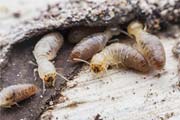All across the state of Texas, termites are thriving, and they’ll continue to flourish despite the colder temperatures that accompany winter months. Since termites can cause a great deal of structural damage, costing homeowners thousands of dollars with each incident, it is critical that you learn how to identify their presence. In fact, it’s important to realize that just because you don’t see them as frequently in the winter, they are more than likely still within or near your home.
How Do Termites Survive Texan Winters
Once the colder weather arrives, termites are usually prepared for it. They have amassed a large food supply to get them through chillier days. Once the temperatures begin to fall below freezing, termites head deeper into the ground, where they remain until sunnier, hotter days return. The termites stay warm as long as they burrow to an area directly below the frost line.
Before and after the temperatures drop below freezing, termites live comfortably within the walls and floors of your home. Since your home is heated, the termites do not experience the coldness of the outside temperatures. They won’t be as active as they are during warmer months, but they will continue to feed on your home’s wooden support structures.
Identifying Termites in Your Home
A trained termite professional can easily identify active colonies of these pests in your home in Texas, even in the winter.
What Types of Termites Live in Texas
Five species of destructive termites exist in Texas. They include each of the following:
-
- Western drywood termites
- Eastern subterranean termites
- Formosan subterranean termites
- Arid-land subterranean termites
- Desert dampwood termites
Signs of a Termite Infestation
While the best and most efficacious way to identify termites in your home is to bring in a professional to complete a thorough inspection for you, it is a good idea to be aware of the signs of an infestation so that you can recognize you have a problem and get it taken care of while it is still relatively small. Here are the signs you should look for:
- Mud tubes
- Discarded termite wings
- Wood damage
- Termite droppings
- Bubbling or peeling paint
Tools Used by Professional Termite Inspectors
A professional inspection of your home is more thorough and generally more accurate. The inspector has specialized tools that are used to determine the presence of these pests, including:
Moisture meter – Termites generally enjoy living in wood with high moisture content. A moisture meter can identify areas of the home with higher levels of moisture. This could suggest that you already have an infestation or that your home is at a higher risk of experiencing one.
Probing tool – This devise is used to identify signs of damage and to test the soundness of structural pieces of wood. If termites are present, the walls of your home will sound hollow when you tap on them.
Infrared camera – This type of camera can locate the presence of termites inside the walls of your home as well as beneath it. It can also be used in place of the moisture meter since it also identifies areas experiencing high moisture content.
If you suspect that you have termites, you should conduct an inspection of your own on your home. If you want a more accurate result, call in a termite specialist to give your home a thorough termite inspection. The more quickly you act, the less damage the termites have time to create.

